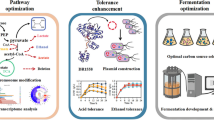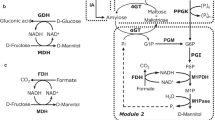Abstract
The influence of residual ethanol on metabolism of food grade Gluconacetobacter xylinus I 2281 was investigated during controlled cultivations on 35 g/l glucose and 5 g/l ethanol. Bacterial growth was strongly reduced in the presence of ethanol, which is unusual for acetic acid bacteria. Biomass accumulated only after complete oxidation of ethanol to acetate and carbon dioxide. In contrast, bacterial growth initiated without delay on 35 g/l glucose and 5 g/l acetate. It was found that acetyl CoA was activated by the acetyl coenzyme A synthetase (Acs) pathway in parallel with the phosphotransacetylase (Pta)-acetate kinase (Ack) pathway. The presence of ethanol in the culture medium strongly reduced Pta activity while Acs and Ack remained active. A carbon balance calculation showed that the overall catabolism could be divided into two independent parts: upper glycolysis linked to glucose catabolism and lower glycolysis liked to ethanol catabolism. This calculation showed that the carbon flux through the tricarboxylic cycle is lower on ethanol than on acetate. This corroborated the diminution of carbon flux through the Pta-Ack pathway due to the inhibition of Pta activity on ethanol.




Similar content being viewed by others
References
Asaï T (1968) Acetic acid bacteria, 1st edn. University Press, Tokyo
Berg P (1956) Acetyl adenylates: an enzymatic mechanism of acetate activation. J Biol Chem 222:991–1013
Bergmeyer IU (1983). Acetate kinase. In: Bergmeyer IU (ed) Methods of enzymatic analysis, 3rd edn, vol 2. Academic Press, New York, pp 127–128
Birgitt M, Prüss M, Wolfe AJ (1994) Regulation of acetyl phosphate synthesis and degradation and the control of flagellar expression in Escherichia coli. Mol Microbiol 12:973–984
Chotani G, Dodge T, Hsu A, Kumar M, LaDuca R, Trimbur D, Weyler W, Sanford K (2000) The commercial production of chemicals using pathway engineering 1543:434–455
Cozzone AJ (1998) Regulation of acetate metabolism by protein phosphorylation in enteric bacteria. Annu Rev Microbiol 52:127–164
De Ley J, Gillis M, Swings J (1984) Family vi. Acetobacteraceae. In: Krieg NR, Holt JG (eds) Bergey's manual of systematic bacteriology, vol 1. Williams and Wilkins, Baltimore, pp 267–278
Deppenmeier U, Hoffmeister M, Prust C (2002) Biochemistry and biotechnological applications of Gluconobacter strains. Appl Microbiol Biotechnol 60:233–242
Duboc P, von Stockar U (1998) Systematic errors in data evaluation due to ethanol stripping and water vaporization. Biotechnol Bioeng 58:428–439
Hosono A (1997) Characterization of a water soluble polysaccharide fraction with immunopotentiating activity from Bifidobacterium adolescentis m101–4. Biosci Biotechnol Biochem 61:312–316
Iannino IN de, Couso R-O, Dankert M-A (1988) Lipid-linked intermediates and the synthesis of acetan in Acetobacter xylinum. J Gen Microbiol 134:1731–1736
Klotzsch HR (1969) Phosphotransacetylase from Clostridium kluyveri. In: Bergmeyer IU (ed) Methods in enzymology, 2nd edn, vol 13. Academic Press, New York, pp 381–386
Kumari S, Beatty C, Browning DF, Busby SJW, Simel EJ, Hovel-Miner G, Wolfe AJ (2000) Regulation of acetyl coenzyme a synthetase in Escherichia coli. J Bacteriol 182:4173–4179
Luttik MAH, van Spanning R, Schipper D, Vandijken JP, Pronk JT (1997) The low biomass yields of the acetic-acid bacterium Acetobacter pasteurianus are due to a low stoichiometry of respiration-coupled proton translocation. Appl Environ Microbiol 63:3345–3351
MacCormick CA, Harris JE, Gunning AP, Morris VJ (1993) Characterization of a variant of the polysaccharide acetan produced by a mutant of Acetobacter xylinum strain cr1/4. J Appl Bacteriol 74:196–199
Matsushita K, Toyama H, Adachi O (1994) Respiratory chains and bioenergetics of acetic acid bacteria. Adv Microb Physiol 36:247–301
McCleary W, Stock JB, Ninfa A (1993) Is acetyl phosphate a global signal in Escherichia coli? J Bacteriol 175:2793–2798
Nagaoka M (1994) Anti-ulcer effects of lactic acid bacteria and their cell-wall polysaccharides. Biol Pharm Bull 17:1012–1017
Naritomi T, Kouda T, Yano H, Yoshinaga F (1998) Effect of ethanol on bacterial cellulose production from fructose in continuous-culture. J Ferment Bioeng 85:598–603
Oda M (1983) Anti-tumor polysaccharide from Lactobacillus species. Agric Biol Chem 47:1401–1412
Prüss BM (1998) Acetyl phosphate and the phosphorylation of ompr are involved in the regulation of the cell division rate in Escherichia coli. Arch Microbiol 170:141–146
Rose IA, Grunberg-Manago M, Korey SR, Ochoa S (1954) Enzymatic phosphorylation of acetate. J Biol Chem 211:737–756
Ross P, Mayer R, Benziman M (1991) Cellulose biosynthesis and function in bacteria. Microbiol Rev 55:35–58
Saeki A, Taniguchi M, Matsushita K, Toyama H, Theeragool G, Lotong N, Adachi O (1997) Microbiological aspects of acetate oxidation by acetic acid bacteria, unfavorable phenomena in vinegar fermentation. Biosci Biotechnol Biochem 61:317–323
Saeki A, Matsushita K, Seiki T, Taniguchi M, Toyama H, Theeragool G, Lotong N, Adachi O (1999) Enzyme responsible for acetate oxidation by acetic acid bacteria. Biosci Biotechnol Biochem 63:2102–2109
Schüller G, Hertel C, Hammes WP (2000) Gluconacetobacter entanii sp. Nov., isolated from submerged high-acid industrial vinegar fermentations. Int J Syst Evol Microbiol 50:2013–2020
Schulze U (1995) PhD Thesis. Technical University of Denmark. Lyngby, Denmark
Takemura H, Kondo K, Horinouchi S, Beppu T (1993) Induction by ethanol of alcohol dehydrogenase activity in Acetobacter-pasteurianus. J Bacteriol 175:6857–6866
Trujillo LE, Arrieta JG, Dafhnis F, Garcia J, Valdes J, Tambara Y, Perez M, Hernandez L (2001) Fructo-oligosaccharides production by the Gluconacetobacter diazotrophicus levansucrase expressed in the methylotrophic yeast Pichia pastoris. Enzyme Microb Technol 28:139–144
Weinhouse H, Benziman M (1972) Regulation of gluconeogenesis in Acetobacter xylinum. Eur J Biochem 28:83–88
Weinhouse H, Benziman M (1974) Regulation of hexose phosphate metabolism in Acetobacter xylinum. Biochem J 138:537–542
Acknowledgements
Financial support from the Swiss Commission for Technology and Innovation CTI 4491.2 is gratefully acknowledged. Experiments presented in this study comply with the current laws of Switzerland.
Author information
Authors and Affiliations
Corresponding author
Rights and permissions
About this article
Cite this article
Kornmann, H., Duboc, P., Niederberger, P. et al. Influence of residual ethanol concentration on the growth of Gluconacetobacter xylinus I 2281. Appl Microbiol Biotechnol 62, 168–173 (2003). https://doi.org/10.1007/s00253-003-1299-2
Received:
Revised:
Accepted:
Published:
Issue Date:
DOI: https://doi.org/10.1007/s00253-003-1299-2




